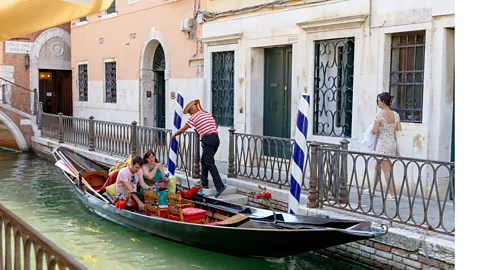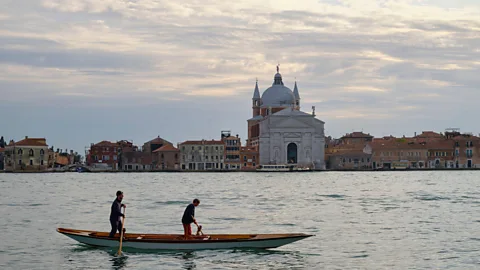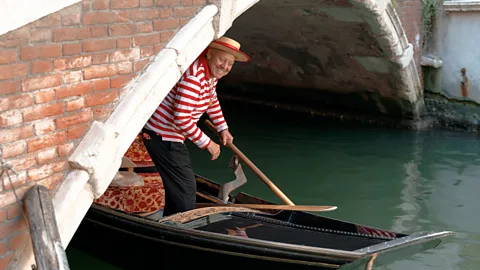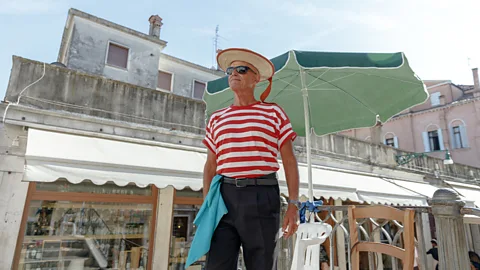A unique way to see a hidden side of Venice
 Carola Cappellari
Carola CappellariSmaller than gondolas, "sandoli" are ancient boats that have been used by everyday Venetians for centuries. Today, they whisk travellers to quiet corners Venice where other boats can't go.
It is 09:00 in Venice and a peaceful silence blankets the city's narrow streets and canals. Day-trippers begin to descend on the lagoon, while Luca Padoan leans against a wall near the Rio della Misericordia, one of the canals cutting through the former Jewish Ghetto. As he watches the neighbourhood come alive from behind his sunglasses, a few tourists approach, cautiously asking if they can photograph the handmade sandolo boat moored to his left.
"I have always explained that this is not a gondola, but its progenitor," Padoan said, stroking its oar.
While Venice is synonymous with the many ornate gondolas that ply its canals, very few people know about the boat's lesser-known relative, the sandolo, that once populated Venice's waterways. Characterised by a steel "curl" on the prow and typically painted midnight black, these flat-bottomed rowing boats were historically used to navigate the shallow waters of the lagoon and to transport goods and people from Venice to the Italian mainland.
"If you do not understand the origin of the city and its evolution, you cannot explain the historical importance of the sandolo. The average depth of the lagoon [in the past was incredibly shallow]. With a normal boat, you couldn't get there," explained Valentino Scarpa, who oversees the nine stazi (stations) where sandolo boats continue to carry Venetians and tourists through the canals today.
 Carola Cappellari
Carola CappellariThe earliest written references of sandoli (the plural of sandolo) date back to 1292. Unlike gondolas, which have always been used for transportation, sandoli were historically used for fishing, racing and hunting as well as ferrying people and building materials throughout the lagoon. Sandoli are also slightly shorter, wider and less ornate than their more popular counterparts. Gondolas typically have two pointed ends: an S-shaped bow depicting the sinuous design of the Grand Canal that crosses the city, and an iron stern. In contrast, sandoli have a painted prow; a flat, open stern; and are less lavish.
These physical differences serve a few practical purposes. In a gondola, the rower typically stands on the side, while a sandolo's symmetrical bottom allows the rower to stand in the middle of the boat. This centralised rowing stance allows for more balanced weight distribution, which increases speed, and its symmetrical design enables the sandolo to carry heavier loads than a gondola with less risk of tipping.
Like gondolas, sandoli are usually rowed with one oar, but they can also be rowed using two oars at the same time. This technique, known as voga alla vaesana in Venetian, was historically used in areas of the lagoon like Caorle, Marano and Grado to practice valliculture, a medieval fish-farming method pioneered in the Venetian lagoon.
"Historically, every family owned a sandolo. It was the means used in the city to carry people around, to procure food, to fish, and to transport materials," said sandolo rower Livio Bon.
 Alamy
AlamyBut Scarpa explained that as Venetians began to realise that rowing a gondola was easier than rowing a sandolo, these ancient boats started to be replaced by gondolas.
"It's clear that being able to go with two oars [in a sandolo] is an evolution because it allows you to go faster. However, the gondola, being asymmetrical, is more manageable and easier to row in small canals," Scarpa explained. "The gondola [became] more and more popular, leading to the authorisation of more gondolas. As a result, the gondolier category has become more dominant, and the number of sandoli in the lagoon has decreased."
Riding in a sandolo
Sandoli operate from nine stazi (stations) in Venice and cost the same as a gondola ride: from 09:00 to 19:00, rides last 30 minutes and cost €90 per boat (which can be shared by the boat's maximum of five passengers). From 19:00 to 04:00, rides last 35 minutes and cost €110.
Today, only 20 sandolisti (sandolo rowers) are left in Venice, compared to 433 gondolieri (gondola rowers). Yet, according to the few remaining sandolisti, riding through the canal in a sandolo is one of the most unique ways to experience Venice's history. Not only do most sandolisti believe its design inspired the gondola and it holds a nostalgic place among many Venetians, it can also explore areas of the city where gondolas can't go.
While gondolas are allowed to pass by the areas where the nine stazi are located, only sandoli are permitted to venture through them. Riding in a sandolo therefore offers tourists a unique opportunity to explore less-crowded historical landmarks where gondolas aren't permitted, such as the Jewish Ghetto, the Ponte dei Greci and the Ponte dell'Olio, among other areas. What's more, because a sandolo is shorter than a gondola, it can navigate narrower canals to less-explored pockets of the city.
 Carola Cappellari
Carola Cappellari"It is a purely traditional job, handed down from generation to generation, and that tells Venice's story," said Chiara Favaro, the daughter of a sandolo rower. "When you are on a [sandolo], you see the city through other eyes – a hidden Venice, the authentic one. The sandolista can tell you things that a tourist guide doesn't know because the stories are often handed down from grandfather to father to son."
Such was the case with Padoan. "I started when I was seven years old with my grandfather, who had a similar boat with which we used to go fishing. [Now] I have been doing this job for 26 years," the 53-year-old said, lowering himself onto his sandolo's cushioned seat. "From November onwards, I dedicate myself to the boat's maintenance: I repaint it while my mum fixes the cushions. Ours is a family business." Then in March, with the arrival of spring, it's time to row again.
Like Padoan, Scarpa was also introduced to the trade at a young age, spending his weekends from the age of seven learning how to row with his father. After attending university, he returned to Venice to refine the craft.
Today, not everyone is willing to continue what has traditionally been a family business. While this generational pastime has faded, it has also opened the door for aspiring rowers whose families haven't historically been sandolisti to enter the trade.
 Carola Cappellari
Carola CappellariThe Municipality of Venice holds competitions for aspiring sandolisti to apply for licenses in order to join in this profession. To qualify, applicants must complete a professional navigation course, as well as pass a rowing and a swimming test.
"First I repaired household appliances, then I worked as a taxi driver and then I went back to repairing appliances," another sandolista, Mariano Pozzobon says, wiping his face with a blue handkerchief after returning from a ride with some tourists. "I got here through friendships, and now I have been doing this job for 30 years", he concludes.
Other sandolisti agree that there's no other job they'd rather do, and that operating these quintessentially Venetian vessels is more than just a profession.
"Each boat is a world of its own. It [was] a family job where love is passed on. It is not simply a job with an economic return, but a passion," Scarpa says. "It's a job that you only find here: and doing it makes you feel even more Venetian."
 Alamy
Alamy"When [tourists] get off, they have to be ecstatic. They have to feel the sound of the water of the canals in their ears, the breeze in their necks, the boat swaying under the weight of the driver. They must breathe beauty," Bon said, while helping a French couple settle into his sandolo. "The sandolo allows you to fully savour the history of Venice."
--
If you liked this story, sign up for The Essential List newsletter – a handpicked selection of features, videos and can't-miss news, delivered to your inbox twice a week.
